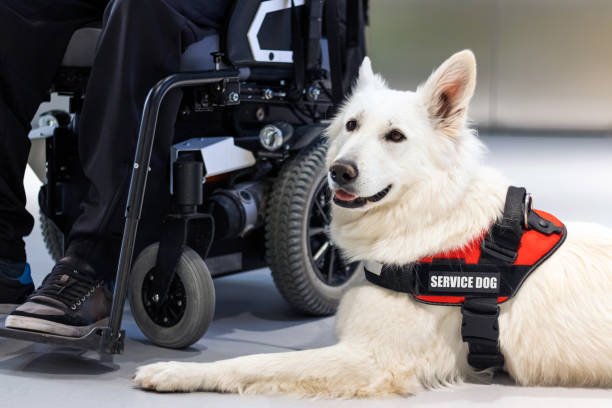
Dogs have always been recognized as humans’ best friends. They are great companions and helpful to humans. Dogs enjoy working for their owners and have been working for as many—if not more—years than they’ve been serving as our sweet and loyal pets.
According to Share America, there are at least 500,000 service dogs in the United States alone. I know most of you have been hearing about service dogs but don’t know their real meaning. A service dog is a specially trained dog that offers invaluable assistance to individuals with disabilities. These remarkable dogs are capable of carrying out a wide range of tasks tailored to meet the unique needs of the people they support.
While service dogs may differ from working dogs, they all have in common their legal right to enter all public spaces and the fact that they are not “pets” but dogs with important jobs to carry out. Here are eight types of service dogs and their valuable roles.
Guide Dogs

The first generation of service dogs, guide dogs, has played a crucial role in assisting people who are blind or visually impaired. These exceptional dogs not only guide their owners around obstacles but also help them navigate through public spaces with ease. Additionally, they provide valuable support by aiding their handlers in navigating stairs and other physical obstacles. In general, guide dogs just help their owners move from one place to another with ease.
You’ll usually see guide dogs in a special harness with a bar for their humans to hold on to for support. Guide dogs often wear vests with the words “Do not pet me,” since it’s essential not to distract them from their important work. One of the remarkable qualities of guide dogs is their “selective disobedience,” which means they can follow commands but also make decisions based on their own judgment.
Hearing Dogs

Similar to guide dogs, which act as eyes for their owners who cannot see, hearing dogs also help in the same way, just that they act as ears for those who are deaf or hearing impaired.
Hearing dogs are trained to alert their humans to important sounds, like knocks on the door and doorbell, fire alarms, baby cries, and alarm clocks. Hearing dogs help by bringing deaf individuals into the hearing world, and hearing dogs help their humans stay connected to their environments and function with more independence.
Being deaf can be an incredibly isolating experience. Hearing dogs will make physical contact with their handlers based on the noise, leading them either to the source or away from it.
Seizure Alert Dogs

Seizure-alert dogs can tune in to subtle changes in human behaviour, a trait that can be a lifesaver for people with epilepsy. These dogs are trained to recognise the signs that their handlers are about to have a seizure, and from there, they can alert for help and position themselves “in a manner that protects the individual during the seizure itself.”Interestingly, there’s still no scientific understanding of how seizure-alert dogs recognise that a seizure is imminent, nor is there even proof “dogs can be trained specifically to perform this task.”
Diabetic Alert Dogs

Dogs have about 300 million olfactory receptors in their noses; compared to humans, their sense of smell is anywhere from 10,000 to 100,000 better. This impressive smelling capability comes with the ability to smell things we humans can’t, including chemical changes in blood sugar.
For people with diabetes, this means they can be alerted to blood sugar drops before they reach dangerous levels, and if they do experience a critical drop, others can be alerted. This provides people with diabetes with a sense of security and independence they may not have experienced before.
Allergy Detection Dogs

The keen sense of smell of our beloved dog has come to play a role here again for children and adults with allergies. Allergy detection dogs are trained to use their remarkable sense of smell to detect even trace amounts of allergens in the air or food. These specially trained dogs play a crucial role in alerting their humans to the presence of allergens, providing a sense of safety and security for individuals with allergies. They often work closely with children, accompanying them to school and various activities, which increases the children’s independence and provides parents with peace of mind knowing that their children are protected from potential allergen exposure.
Autism Support Dogs

Autism is not a physical disability, but support dogs for individuals with autism play a crucial role in maintaining the well-being of their handlers. These dogs are trained to assist their handlers in navigating social settings, which helps build up their confidence and reduce anxiety. Additionally, they are trained to keep track of autistic children who tend to wander, providing safety and security for individuals and their families.
Autism support dogs play a crucial role by offering companionship and non-judgmental support to individuals with autism, especially those who struggle to connect with other people. These dogs are valuable for helping autistic individuals enhance their communication abilities and manage their emotions effectively.
Mobility Assistance Dogs

Mobility assistance dogs play a crucial role in improving the quality of life for individuals with impaired motor functions, particularly those who rely on wheelchairs for mobility. These highly trained dogs can perform various tasks, including pulling wheelchairs up ramps, pressing elevator buttons, and assisting their handlers with daily activities. Their support is invaluable and essential in helping individuals with disabilities navigate the world more independently and easily.
In addition to aiding people in wheelchairs, these amazing dogs also assist individuals with conditions such as arthritis, cerebral palsy, muscular dystrophy, and spinal cord injuries. Their support is invaluable in enhancing the independence and quality of life for those facing these mobility challenges.
Psychiatric Service Dogs

Mental health disorders such as post-traumatic stress disorder (PTSD), depression, and bipolar disorder can have a profound impact on individuals. Those affected by these conditions may struggle to manage daily activities, experience difficulty leaving their homes, and endure frequent panic attacks or overwhelming discomfort in social environments.
Psychiatric service dogs are crucial in providing comfort and support during emotional distress. These specially trained dogs can perform a wide range of tasks, such as creating a protective buffer around their handlers and even turning on lights in a room before their handler enters, to help develop a sense of safety. It is important to differentiate psychiatric service dogs from emotional support dogs or therapy dogs, as they undergo rigorous training and are not considered pets under the legal definition despite the emotionally driven nature of many of their tasks.
Also read:Types of Working Dog Breeds
Conclusion
When you encounter a service dog in a public setting, it’s important to respect that they are working and avoid distracting them, even if you want to say “hello.” It’s also essential to recognise that not all disabilities are apparent. Some individuals may appear perfectly capable, but their service dogs are vital for helping them navigate certain allergens or alerting them to oncoming seizures.
As our understanding of dogs and their remarkable abilities expands, the variety of service and working dog types grows. Whether a dog is a trained service animal or a beloved pet, we can all acknowledge that they are incredible.
Leave a Reply